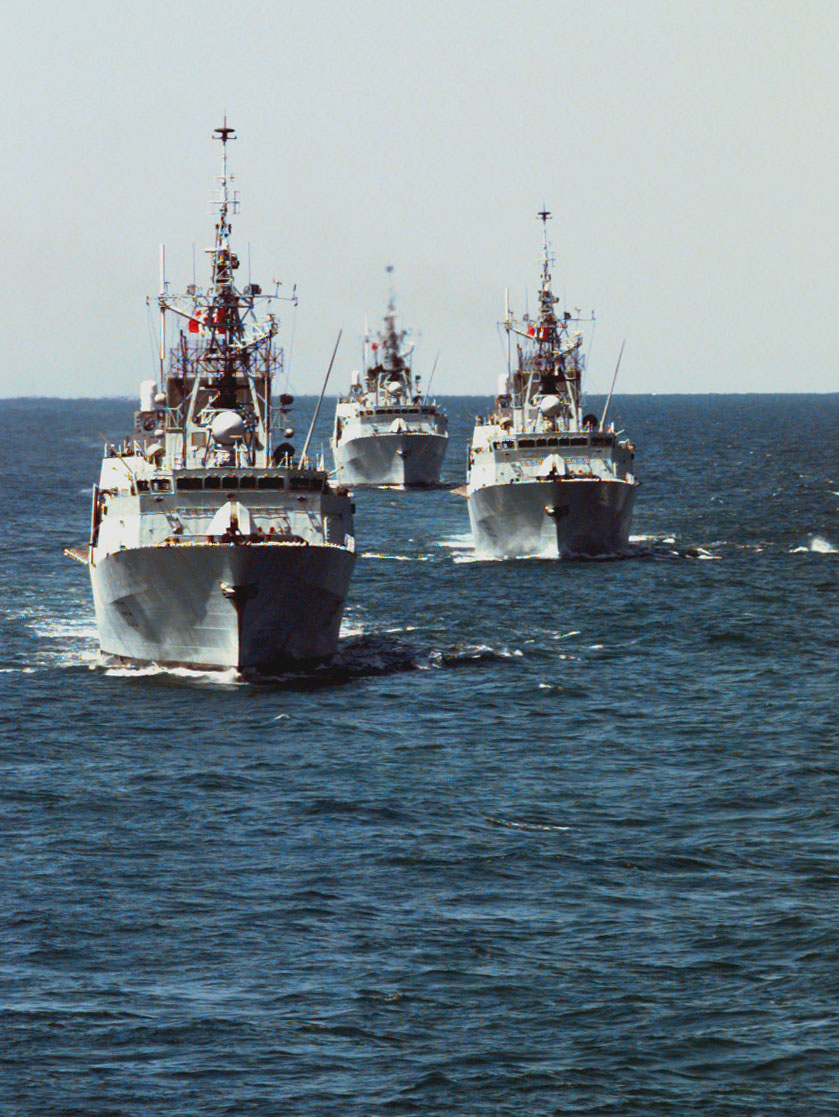Touraj Riazi had the great privilege of interviewing former director of the Missile Defense Agency Lt. General (Ret’d) Patrick O’Reilly. Lt. Gen. O’Reilly enjoyed a lengthy and distinguished career in the Army where he occupied a variety of positions including Program Manager for the Directed Energy Programs, Patriot Missile PAC 3, THAAD, and the Ground based Midcourse Defense Program. Lt. Gen. O’Reilly culminated his career with being appointed Director of the MDA from 2008-2012. Part 1 of our interview can be found here.
Do you think BMD is a cost effective way of augmenting a nation’s credible deterrence?
Yes, but it depends on how you calculate cost effectiveness. If you calculate it through comparing the cost of an offensive missile versus the cost of a missile defence system, the offensive missiles are always going to be less costly. The calculation changes completely, however, if you calculate the value of what you are trying to protect or if you are looking at some other alternative. So when you say cost effectiveness, you really have to define what you are counting in those costs.
If a missile defence system causes an adversary with offensive missiles to have uncertainty in whether or not they are going to be successful in their attack, you first have to wonder why is there an attack. More importantly though, if someone is sophisticated enough to have a missile defence system, they are definitely going to be sophisticated enough to retaliate and there is a very low probability that someone is going to defend themselves against a provocative attack by somebody else and then not retaliate. So if you are in offence and there is a BMDS involved in this calculation, you have to calculate the fact that there is an uncertainty now of whether you are going to be successful in your offence.
You might even be partially successful, but is that going to allow whoever you are attacking to have a successful counter attack? If you are attacking someone who has a bigger arsenal than you have, that is not a very favourable calculation. From a deterrence point of view, without BMD, you are subject to being deterred by whoever has the offence. That deterrence could be a way of regional hegemony or could simply mean an adversary is able to exert their will freely on you, in a way that is negative to you, without worrying about the consequences of using that offence as a threat. But, if there is a missile defence system involved the calculation changes because it is not just about the cost of an offensive missile versus an interceptor. That really changes the deterrence question.
I have also seen calculations to account for what you are trying to protect and not only the attack of, let’s say a city, or a military asset. It’s not just the value of that asset, it’s the value of the freedom of trade and the freedom of a nation or a state to be able to participate freely in it’s region without being inhibited by the threats of someone’s missiles. I have seen so many different answers to your question and in my mind it always depends on where you draw the boundary of what you are gong to calculate in the term cost effectiveness.
Do you think then that any nation’s deterrence posture would suffer from deficiencies should it not possess a credible ballistic missile defence system, for the very reason that that uncertainty is absent from your calculation?
If your potential adversary, or whoever you are worried about, does have offensive missiles, and you don’t have a missile defence, you are led to the logic of either having to consider a preemptive attack, which is destabilizing, or you have to have the will to operate in the face of an adversary who can directly threaten your population.
It’s not just yourself but it’s the other states that you want to operate with. I’m concerned that if you did not have any type of BMDS or you didn’t have a relationship with an ally who does have a missile defence system, and you feel threatened by an offensive system, a destabilizing situation is created.
You either tolerate the threat from your potential adversary and that requires political will of not only the leadership of your country, but it’s population, and any nation you have relations with on the world stage. Or, your adversary is going to force you to try to counter by other means which, for example, could be building a military capacity so large that the offensive missiles are not going to be able to destroy it. So you can build up your own forces if you don’t want to use missile defence. You can double the size of your military which would make it more difficult to prevent a counterstrike and also you get into the area of preemptive attack as an alternative policy.
I think those are extremely expensive alternatives to having a missile defence system, if that’s the case. However, if you want to come from a point of view of other means, you could try to develop and design other means of missile defence, but I don’t know the exact status of those technologies.
Directed energy is promising and it has made great strides during my career. I originally worked with it in 1990. From 1990 till now it’s made great progress, but it does not have the same capacity that an interceptor type system would have. It still could be useful and still could be an alternative but it’s going to still take a lot of development before it gets to the point where I think it could be effective as an alternative to an interceptor-based missile defence system.
Do you think the destabilization created by that situation is better or worse when compared to the destabilization created by one nation having a defence system and the other not having one?
I don’t understand the logic behind that reasoning because a BMDS is purely defensive and if you have a missile defence system it should not be threatening to somebody else.
Now a defensive missile system with an offensive system- that’s different. But, in the case of just having a missile defence, the missile defence in itself has no offensive capability. And, if your neighbour has a missile defence system and no intent of attacking, then as far as you’re concerned, your neighbour wasted his time. If you have no intent on attacking your neighbour, then I don’t think there would be a situation where a defensive system would be seen as threatening.
Now, we have situations in the world today where the U.S. has tremendous offensive capability, greater than anybody else in the world. There are some areas where China is growing on its strategic side and we have parity through our agreements with Russia; but, the BMDS in those cases are not designed to counter those threats. That seems to be a shock to many people in government and people in the press, where they do not understand that.
If you go back to the legal deployments and the legal approach that has been taken, it has to be understood that the law of our country is that we develop a limited defence system. A limited defence system by definition means it is only capable of countering a much smaller offensive capability than what a ‘peer’ would have.
So our missile defence systems are by law woefully inadequate against a ‘peer’, someone like Russia. In the case of a country like North Korea, or Iran, which are the two that have been defined within this limited scenario for over a decade, we already have a tremendous offensive capability, orders of magnitude greater than what they possess. So by us adding a missile defence system there, we are not adding much to our already dominant offensive capability.
Adding a BMDS in those cases for us is more of a protection, as the law specifies, against a limited, or accidental strike, and that is how our system has been deployed at the strategic level. So I think BMDS is an effective deterrence against someone developing offensive missiles to terrorize your population, or threaten your allies, or against countries who do not have responsible control over their own military or their own systems. This leaves one vulnerable to accidental missile launches or launches not sanctioned by a state’s government. You leave yourself open to those scenarios if you do not have a BMDS.
Missile defence is an enhancement to a nation’s overall military capability. The cost of missile defence may seem high, but compared to the military budgets of the US which run about a half a trillion dollars per year for the past 20 years, missile defence is an extremely small percentage of those budgets. It enhances a critical capability where no other alternative exists today.
So the introduction of BMD essentially covered an area of vulnerability, namely accidental strikes or other kinds of strikes by countries like North Korea or Iran, but nevertheless did not affect stability at the strategic level against a peer like Russia, who has offensive capabilities that renders BMD ineffective.
Yes, that is something that has really surprised me when I talk to Congressmen and Senators since the Missile Defense Act (M.D Act) of 1999. The law of the U.S. is that we develop and deploy a limited BMDS capability. So when they ask me what capability on a national defence level, would you have against a Chinese submarine off of Mexico, or any submarine almost anywhere, and I said to them that we have no capability, and they replied what are we planning to do to have that defensive capability, and I replied nothing- they’ve always been surprised.
They tell me that you should be out building a capability that could counter Russian or Chinese capabilities and I have said that is not the law of the US. You would have to change the law. And, to be frank, the law is also very practical about the cost.
There does not seem to be a lot of appreciation for, or acknowledgement of, the fact that the M.D. Act of 1999 has never been amended. In 1999, it was established that we would have a limited missile defence capability, and you could argue what a limited capability is, but it is definitely not the capability to counter a large offensive strike from a sophisticated adversary such as Russia.
Again the sheer number of interceptors needed are one thing; but, an even greater consideration for expanding a national missile defence system is the significant amount of construction -least decades- to completely build brand new missile fields. The missile field we have today is in Alaska and it happens to work extremely well against any threat from North Korea or Iran. However, it’s not in an ideal location and its sensors are in the wrong place to counter missile threats from China or Russia or anything from the South. It’s not a system with much defence capability at all from missile threats launched from South America. I know there are probably other motivations behind Russia and others complaining about our missile defence system; but, from a technical point of view, their arguments are fairly ridiculous because it’s very easy to see that we are very vulnerable from strikes from a different geographical location.
There has been a lot of criticism directed towards BMD, especially the Ground based Midcourse Defence (GMD) system, that it is not a viable defence in the event of an all out attack. However, your response would be that BMDS is not legally mandated to be one?
Yes, I have had to express that to Congressmen before- that is a fact. I’ve been dealing with Congressmen for over a decade and I’ve had hundreds and hundreds of interactions with them, and I’d be less than truthful to deny that some of them have conveyed to me that they thought we were building a missile defence system that would be effective against a peer type threat. They are in the minority but it has happened. I don’t think they have a practical appreciation of what they want would entail. We attempted to do something like that [construct a national missile defence system to counter a strategic peer threat] in the 1980’s. I had some participation in that effort when it was the SDI Organization. At that point we were developing the kind of capabilities to counter a peer threat and it was tremendously expensive and involved tremendous technical advancements that still would be required today to achieve. Since then, we have been developing a limited, but effective, defence against scenarios where a country with a nascent strategic offensive capability could not impose a large cost on us from a deterrence point of view by having some modest capability. That is what has been pursued for the last two decades. There has been progress and setbacks in doing that.
How do you think the complexity of BMD is best simplified for everyday citizens who need to understand the importance of BMD and the role of agencies like MDA?
I think it’s a combination of complexity, precision and reliability. Those are the challenges and they have to be addressed. The complexity and precision with which that system has to operate is not unprecedented. It is on par or similar to the space program and man space programs that we have been operating for over 50 years. As we have tragically seen in the space program, one simple component failure, can cause fatal results.
Thus, for missile defence, and space too, we have tried to add as much redundancy and other improvements to ensure that we minimize the significant catastrophes that could happen from the failure of one individual component.
The task is not greater than what we have been doing for decades in the space business and Elon Musk and others are doing that too on the commercial side. They’ve had failures, and they’ve shown successes, and they keep improving their design. Butt, I will say that when I talk to pubic audiences, I make the details of the M.D. Act of 1999 clear right up front, because sometimes there is a perception that missile defence provides a shield, or a dome, of coverage. That dome of coverage of the US against any size missile attack doesn’t exist, and it was never authorized to exist, by the laws of our country.
We are building something to address a precise threat out there that is limited in nature. What the M.D. Act of 1999 did charge MDA to accomplish is to address emerging threats that are limited and new. That occurred under President Clinton and has been supported by all the Presidents since then.
The law of the land is that we need to develop a capability to counter a limited threat by all means technically feasible. When I talk to audiences, I make sure they understand at first that this is not Star Wars. That was the original aspirations of the program, to make nuclear weapons ‘obsolete’. That is probably beyond our technical capability today and definitely beyond our resource capability because of the trillions that would be involved and the amount of the GNP that would have to be invested in such a program. There is no cheap way to do this. It’s still the same hardcore engineering that brings us all the products that we rely on today. These are very precise systems and we continue to try to add redundancy so when something fails you have something else that continues to work and I know that that is what my successor has been doing by looking at his congressional testimonies, as they add components to the system.
Overall, it’s a limited defence on a national level. However, we are much more robust in our tactical and regional missile defence systems than I ever thought we would be. We’ve made a lot of progress in tactical missile defences and we’ve done tremendously more testing. Tactical systems by nature do not cost as much as strategic systems to test, so we have done tremendously more testing.
Photo: Lt. Gen. Patrick O’Reilly via Department of Defense. Public Domain.
Disclaimer: Any views or opinions expressed in articles are solely those of the authors and do not necessarily represent the views of the NATO Association of Canada.




